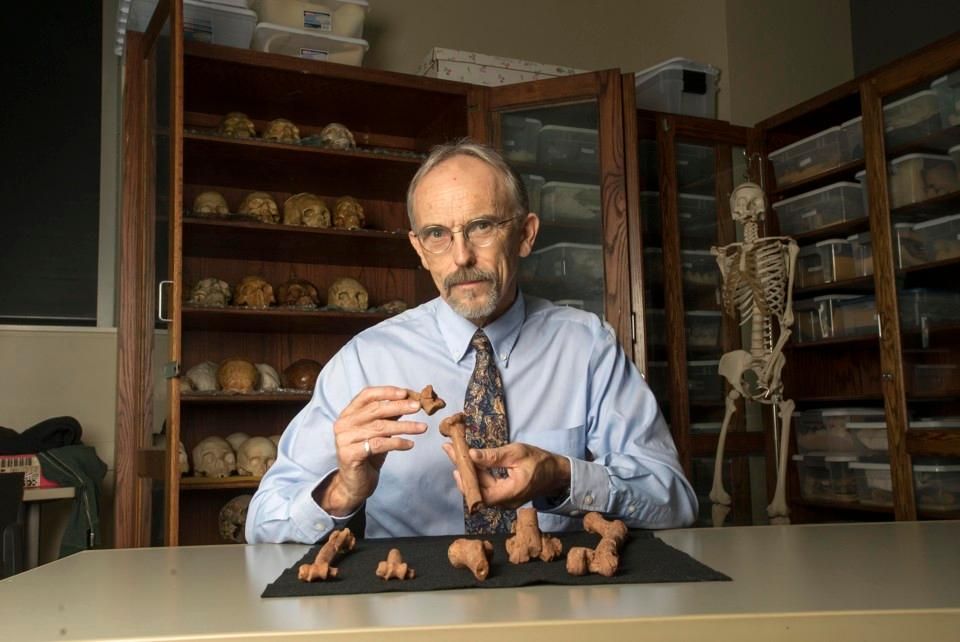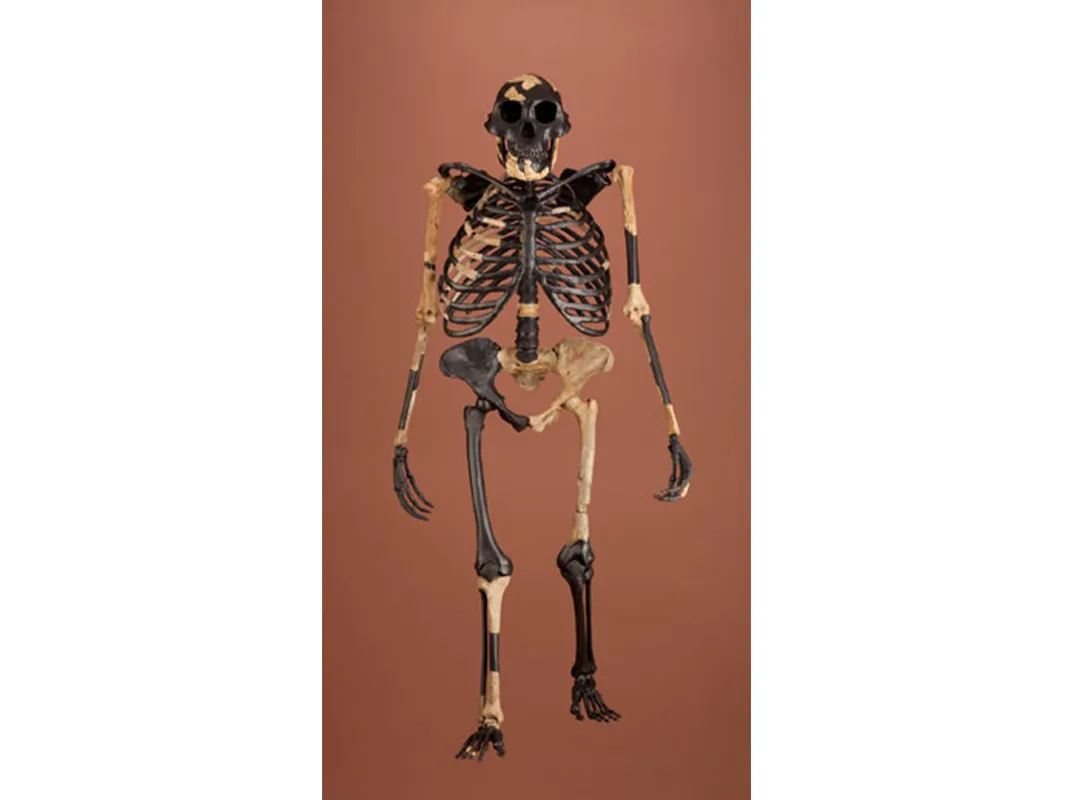Did Anthropologists Just Solve the 3-Million-Year-Old Mystery of Lucy’s Death?
Researchers think they’ve reconstructed the fatal plunge and last terrifying seconds of the hominin’s life
/https://tf-cmsv2-smithsonianmag-media.s3.amazonaws.com/filer/9f/94/9f9454f7-efa7-44df-879a-cba76dc3880c/nature19332-f2.jpg)
It happened in an instant; a sudden slip, perhaps due to an inattentive loss of balance. Within seconds, a typical treetop foray became a terrible, irreversible plunge towards the ground—and death, against which “Lucy” vainly threw out her hands and arms during the final moments of her life.
Scientists have been probing the famed Australopithecus afarensis fossil since her discovery in 1974, yet there’s still more to know about her life. Or in this case, death: This week in the journal Nature, anthropologists used imaging technology, forensic expertise and some good old-fashioned medical analysis to crack a 3-million-year-old mystery and paint a disturbing picture of Lucy's terrifying last seconds.
After ancient bones dry, they often sustain damage on the ground before fossilization or are beaten up afterwards through processes like erosion. But when viewed in CT scans, the breaks in Lucy's bones looked different to John Kappelman, an anthropologist at the University of Texas at Austin. Her right upper arm bone was shattered, with a series of sharp breaks going all the way up to the shoulder.
Kappelman showed the scans to a local orthopedic surgeon, Stephen Pearce. To Pearce, the trauma looked eerily familiar—much like what he sees in his patients every day. “They are consistent with what we see for the sorts of fractures in people who fall from considerable height,” Kappelman explains.
Lucy's injuries suggested that she fell from a height of more than 40 feet, which would mean she was traveling downward at more than 35 miles per hour when she hit the ground. Moreover, the way her shoulder and upper arm bones were compressed into one another and fractured suggest that she had stretched her arms out before her in an unsuccessful attempt to break the impact of her fall.
For Kappelman, that detail created an emotional connection that turned a box of ancient bones he'd studied and taught for three decades into an individual with a sad story.
“We've all fallen, and we know at that instant in time what she was trying to do,” he says. “We can actually fully identify with her at that moment, and I just felt a wave of empathy that I've never felt before with any of the other fossils that I've ever studied. My mind just jumped to seeing this little broken form, bleeding out, lying at the foot of a tree.”

New medical scanning technology provided the first clues that led to untangling Lucy's fate. During a 2008 tour of U.S. museums, she stopped at the University of Texas High-Resolution X-ray Computed Tomography Facility, which can scan even rock-solid materials like fossils, and produces higher resolution images than even a medical CT. The powerful machine let anthropologists see the arrangement of Lucy’s internal bones, which until then had been hidden inside the fossil, for the first time.
Kappelman and others spent 10 days carefully scanning Lucy's skeleton, producing 35,000 separate scans in all. Those showing the end of her right humerus, or upper arm bone, caught his eye: They were distinguished by a series of sharp, clean breaks.
Further analysis revealed other compressive fractures, not as severe but still consistent with the theory of a traumatic fall. The left shoulder, right ankle, left knee and pelvis were all broken. So was the first rib—a break rarely seen in today's emergency rooms, except in cases of severe trauma to the chest.
Study co-author Pearce and other orthopedic surgeons swiftly concluded the likely cause of such injuries. “They see these things every single day,” Kappelman says. “I've had a total of nine orthopedic surgeons look at that right humerus, and they are all of one mind. There wasn't a moment's hesitation for many of them. They just said, 'we see this all the time, it's a four-part proximal humerus fracture.'”
To be sure, Kappelman and colleagues combed through the literature to explore other ways that bones break, from seizures to lightning strikes. But they didn't find anything that looked more likely to explain Lucy's condition then a long fall, which ended when she hit the ground feet first, then fell forward onto the arms she'd outstretched to try to absorb the impact.
The extent of the fractures isn’t the only evidence that Lucy was killed by a fall. The fact that tiny fragments and slivers of bone were also still in place at the fracture sites strengthens the story. “If they'd been produced when the bones were dry they'd have been dispersed,” Kappelman says. “Or if they were older injuries that happened before the person died they'd have started to heal. So they appear to have been sustained at the time of death.”

Lucy is one of more than 300 individuals known from her species, making Australopithecus afarensis, which lived in East Africa between 3.85 and 2.95 million years ago, one of the best-known of all early humans. The species is also one of the most hotly debated among anthropologists, who have long argued over the extent to which human ancestors of different eras lived by climbing trees or by walking around on two feet.
The picture that has emerged is one that blended ape and human characteristics. Lucy and her kin had flat noses and small chimp-sized brains, as well as strong arms and curved fingers that would have aided climbing. However, like more modern humans, they also had small canine teeth, likely used tools, and walked upright on stiff, arched feet that were better for walking than they were for climbing trees.
Lucy was also tiny, standing at 3.5 feet and weighing 60 pounds. That might be why, though she walked upright, she and her kin still took to the trees to forage for food and sleep in safety from most predators.
But the authors suggest that Au. afarensis's feet, so well adapted for upright walking, proved something of a liability when they did climb. Lucy’s feet did not have the hinging flexibility and grasping ability that helps today’s apes move so efficiently aloft. “These features that adapt her for bipedal locomotion on the ground may compromise her ability to climb efficiently and safely in the trees,” they write. At least one other fossil from the Hadar, Ethiopia site where Lucy was found is also known to have compressive fractures consistent with a fall, Kappelman notes.
Rick Potts, director of Smithsonian's Human Origins Program, said the study's evidence makes a convincing case for how Lucy met her demise—but cautioned against using it to draw broader evolutionary implications.
“Lucy and the several hundreds of fossils of her species show a distinctive skeleton adapted for both efficient bipedal walking and climbing trees,” he said in an email, noting that various studies have emphasized one lifestyle over another. “But the entire combination so beautifully illustrated by Lucy's skeleton is the effectiveness of her species walking and climbing.”
“Based on the fossil hominin record between 6 million and 2 million years ago, this combination was successful for a very long time,” he added. “And so I'm not convinced that Lucy's fatal fall is evidence that the success of life on the ground necessarily compromised the survival benefit—and thus the effectiveness—of climbing in Lucy's species.”
Potts points out that that traumatic falls are relatively common among primates, even particularly agile climbers like gibbons. “Lucy's case, as convincingly shown in the new article, was tragic,” he wrote. “But if witnessed by others of her kind, I bet they would have climbed without hesitation to that same height to get a ripe pod or fruit or a good night's sleep.”